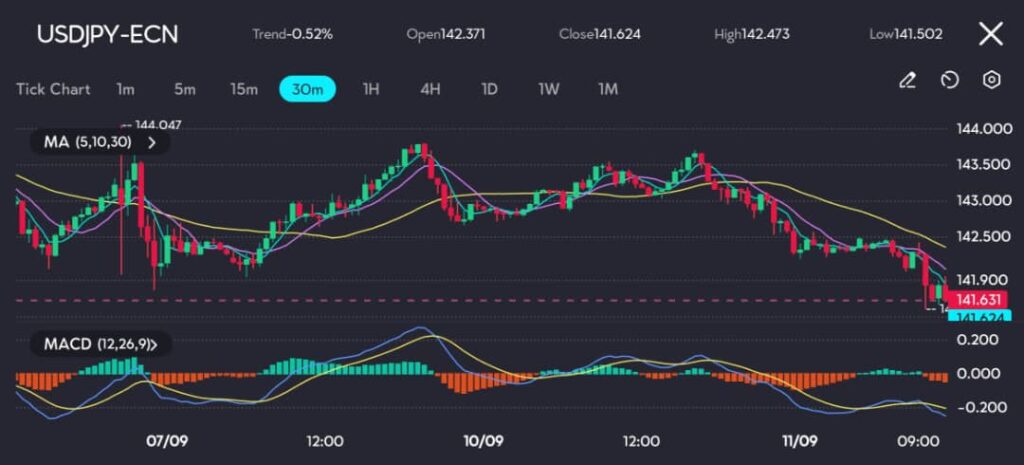Key points:
- Yen approaches a five-week peak, with USD/JPY at 142.18.
- U.S. inflation report could determine the Fed’s next rate cut, with a 69% chance of a 25-basis point cut.
The yen held close to a five-week high on Wednesday, with USD/JPY at 142.18. The dollar was down 0.2% in early trading, and traders are now focused on upcoming U.S. inflation data and the first U.S. presidential debate between Kamala Harris and Donald Trump.
Yen gains momentum amid falling U.S. Treasury yields and market uncertainty
The yen’s strength is largely tied to falling U.S. Treasury yields. Overnight, the 10-year Treasury yield slumped, increasing demand for the yen, which tends to track these long-term yields.
The pair neared its recent low of 141.75 yen, a level last seen on August 5th.

See: Upside prevails for Japanese yen as seen on the VT Markets app.
We look to the charts for more insight. The USD/JPY pair has shown a notable decline in the past few sessions, closing at 141.624 after a high of 142.473. The 30-minute chart reflects a downward trend, with the pair trading below the 5, 10, and 30-period moving averages, signalling persistent selling pressure.
The MACD histogram is printing negative bars, indicating further bearish momentum, and the MACD and signal lines are positioned below the zero level, reinforcing the downward bias.
Given the yen’s traditional role as a safe-haven currency, any potential market volatility from U.S. political developments or economic uncertainties could further support the yen.
Immediate support for USD/JPY lies at the 141.50 level, and a break below this could lead the pair to test the psychological level of 141.00. On the upside, resistance is seen at 142.00, with a potential recovery move only likely if the pair can sustain above this level.
Traders await U.S. inflation data to gauge Federal Reserve’s next move
The upcoming U.S. inflation report is at the forefront of traders’ minds. The data will likely inform the Federal Reserve’s decision on whether to cut rates by 25 or 50 basis points at its next meeting. Current expectations are for a year-on-year rise of 2.6% in U.S. CPI for August, down from 2.9% in July. A lower-than-expected CPI figure could spark concerns about weaker demand in the U.S. economy.
With a 69% chance of a standard 25-basis-point cut and a 31% chance of a more aggressive 50-basis-point reduction, the market appears divided. A softer-than-expected inflation reading could tilt expectations towards a larger cut.
Dollar faces pressure
The dollar index (DXY) held steady at 101.66, slightly below its recent one-week high of 101.77. Against the euro, the dollar was unchanged, with EUR/USD at $1.1019. The euro remains under pressure, having dropped to $1.10155 overnight, its lowest level since August 19.
Sterling was flat at $1.3080, recovering slightly after reaching its weakest point since August 21 in the previous session. Overall, the dollar’s movement hinges on the inflation report and how it aligns with the Federal Reserve’s rate policy.
U.S. presidential debate brings market uncertainty and potential dollar impact
The U.S. presidential debate between Kamala Harris and Donald Trump will add another layer of uncertainty to the market. Traders broadly expect the dollar to strengthen in the event of a Trump victory, as his policies could support fiscal spending and possibly lift interest rates.
On the other hand, a weaker performance from Trump might weigh on the dollar, as markets reassess his economic stance.
Historical data has shown that political debates can have a short-term impact on market sentiment. During the Trump-Biden debates of 2020, there was heightened volatility in the dollar, underscoring the potential for currency moves this time around.
Start trading now — click here to create your live VT Markets account.









